Bank Fishing For Bass Made Easy
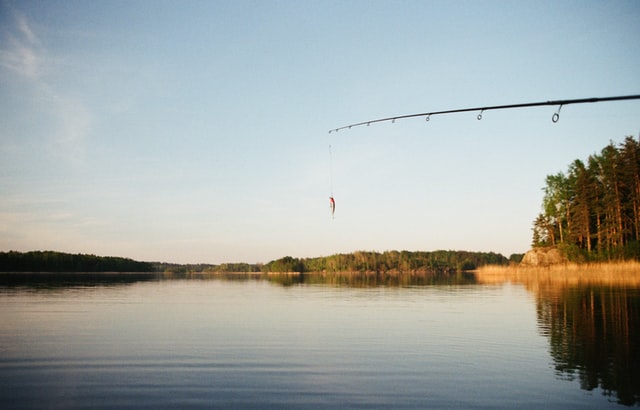
Trying to catch bass bank fishing is very different from fishing from a boat. Fishing from shore limits the amount of gear you can carry with you, meaning the gear you do carry needs to be very versatile. Most people feel the need to have as many baits as possible on hand, giving them the best chance at a perfect bait presentation. The truth is, no one wants to be hauling a load of gear along the shore. The idea is to feel confident with your selection while not being weighed down and tangled up in too much of it.
It may sound easy, but fishing from the bank all year around is not for someone who just wants to sit in a chair and relax and just “wait for something to bite”. The most successful anglers will take a different approach. Even before you hit the water, you need to choose the right gear. Then based on the time of year decide what lures the bass will most likely bite. Third, narrow down what locations the bass will most likely be hanging around. And lastly, verify the area by scanning it with a quality fishing sonar. If you do those things, there you’ll be catching fish in no time!
It can be hard to find that balance if you’re less experienced, but that’s exactly why you’re reading this. I’m here to help you get the best out of bank fishing for bass by choosing the right gear, rods, and tackle bag, how to figure out a waterbody from shore, and so much more!
WARNING: There’s a lot of information about this subject you’ll probably want to come back to. No one expects you to remember all these tips. We know your time is precious, so we really tried to over-deliver in value for you. Additionally, we frequently update reports like this, so you’ll want to stay up to date with any changes or additional tips we include for you.
We found that the easiest way to save and bookmark this report so you can come back to it later is to share it on your favorite social media platform, especially if you use your phone to get important tips like the ones in this report here…
Click on your favorite social media buttons to remember this page now!
Best Rods for Bank Fishing For Bass
When you first start, you’ll inevitably need to try out a few equipment set-ups. It is still important to not wear yourself down with too much gear. It’s best if you stick to bringing along three to four rods. This is just enough to give you the right options for all the different lures you may use. After all, you’re there to relax and enjoy yourself, not win a pro bass fishing tournament!
Shore fishing offers you a TON of opportunity to fish many different lures so here are the rod that will cover the most lure options for you:
I recommend you need only to bring 4 rods:
Rod 1) – Baitcasting rod – 7′ 2″ medium-heavy rod with fast tip.
Line: Spooled with 50-65-pound braid line
Lures: for frogs, buzzbaits,and jig baits.
Rod 2): Baitcasting rod – 6′ 6″ medium action, extra fast tip.
Line: Spooled with 15-20-pound braid (main line) and can either be paired with monofilament or fluorocarbon leader line (depending on your presentation).
Lures: topwater poppers, squarebill, spinnerbaits, swim jigs.
Rod 3): Baitcasting rod – 6′ 6″ medium action, extra fast tip.
Line: Spooled with 12-17-pound fluorocarbon line.
Lures: Lures: shaky head, Texas rigs, smaller jigs..
Rod 4): Spinning rod – drop shot rod 7′ 2″ medium action rod with an extra fast tip.
Line: Spooled with 6-8-pound fluorocarbon line. Lures: worms, fluke baits, soft plastic craws, Senko wacky-style.
Best Hard Baits For Bank Fishing
Poppers
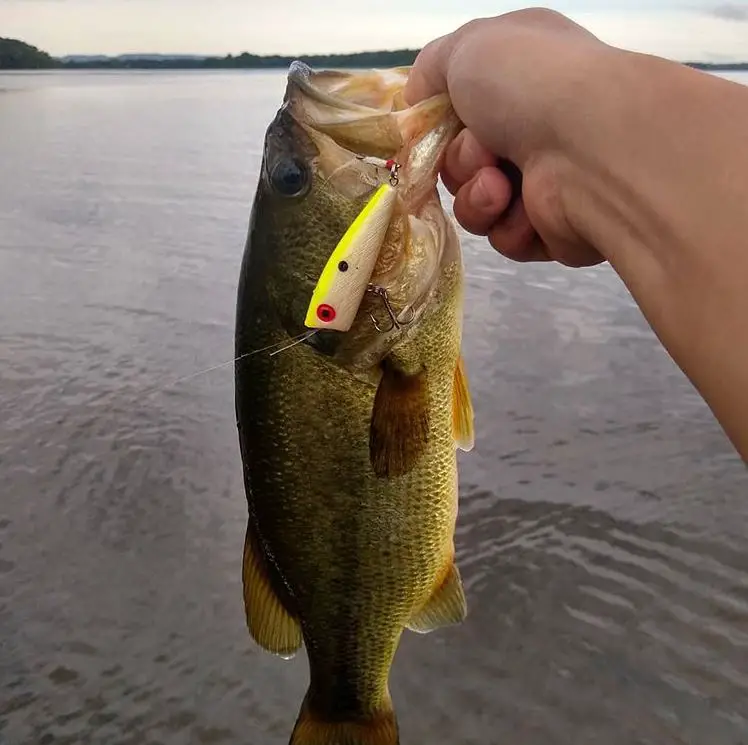
Originally carved from wood and painted to match a baitfish pattern, this proven lure has been designed to move the water around its concave nose. Poppers are meant to mimic a distressed baitfish, frog, or insect that is struggling on the surface of the water.
When the lure is jerked, the hollowed bowl-shaped mouth makes a splashing noise furthering the appearance and sounds of a wounded creature.
These awesome baits are one of the easiest to use for bass fishing and are perfect for beginners. There’s no need for carefully tuned techniques, just cast out and jerk the lure once in a while on the retrieve, reeling in while the lure is at rest.
Buzzbaits
Often forgotten, the buzzbait is truly the perfect weapon for catching monster bass. It’s loud surface noise, blades, wiggling skirt and soft plastic trailer are a recipe for driving bass mad.
It’s the perfect bait when you’re in need of a big bite.
A ⅜-ounce buzzbait is the perfect starting size.
According to Kevin VanDam, “when the fish are using shallow water cover, the buzzbait will flush them out.” Being one of his favorite lures for convincing bass to come out of cover, you can rely on the buzzbait to do the same.
Spinnerbaits
Considered one of the most versatile lures, spinnerbaits or “safety-pin” lures can be used in just about every season and in any kind of condition. It’s also reliable in, over, and around many forms of cover, adding to its flexibility.
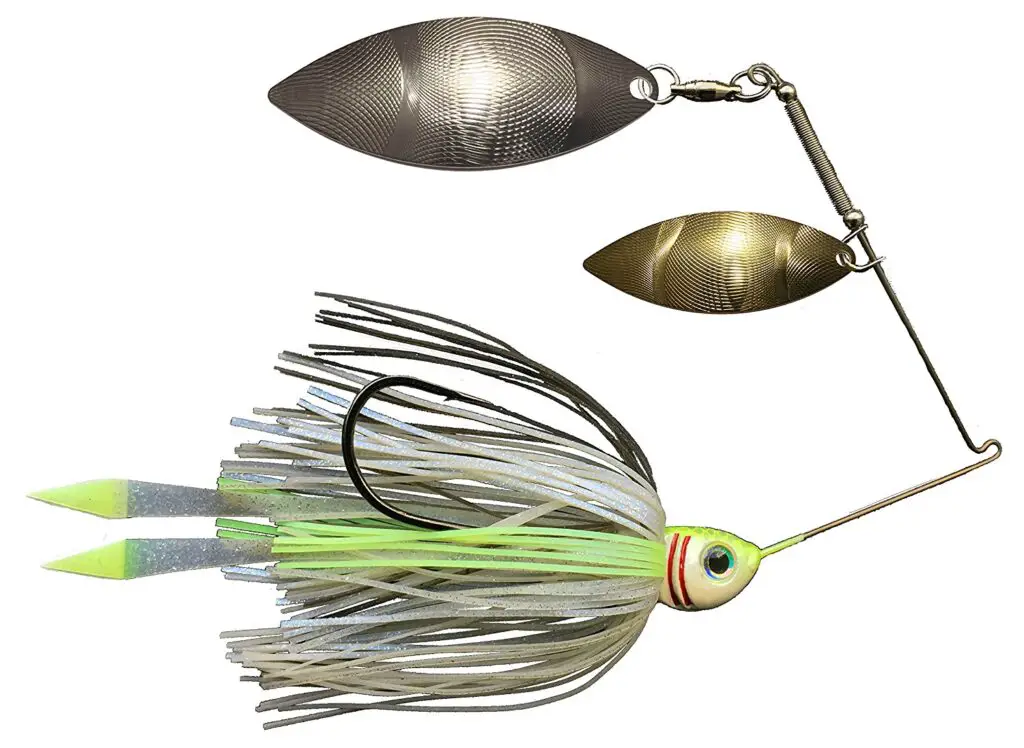
Spinnerbaits consist of a lead head (in various weights) with a wire framework, at least one spinning flasher blades, and a soft-plastic skirt to cover the hook. The shirt can be made of anything from silicon, plastic, “lumiflex” to rubber.
The blades on the spinnerbait create not only visual stimulation from the flashing but also a vibration that mimics swimming baitfish.
There really isn’t a bad time or place to use the spinnerbaits, but they’re especially useful in shallow cover. Typically ¼-ounce baits are used when bank fishing for bass.
Vibrating Jigs/ Chatterbait-Style Jigs
When first released, many thought chatterbaits were just another gimmick like the Banjo minnow; one of those “best bait everyone owns and nobody throws” situations.
However, when professional bass fishermen started to win tournament after tournament it solidified itself in bass fishing bait history that it’s a proven lure to catch fish year-round.
Being a mix between a spinnerbait, crankbait, and a jig, it gives off a great heavy vibration.
Choose a ¼-ounce chatterbait and you won’t be disappointed.
As Brett Hite put it, “Once I put a big swimbait on it, it became more of a square-billed swimbait to me,” with its deflection ability, it definitely has that ability to gain some attention.
Read the Spring Bank Fishing section to learn how I use chatterbaits.
Jigs
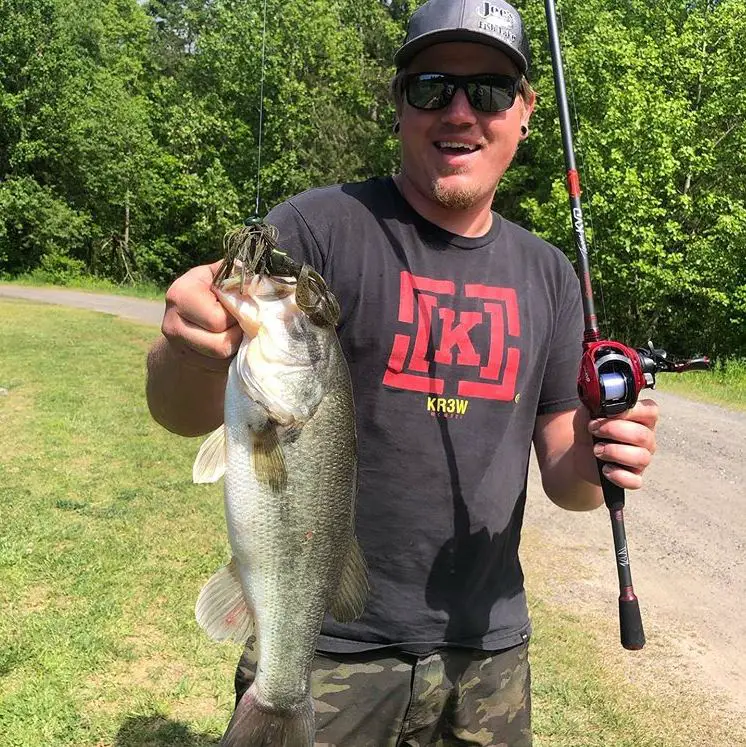
It’s simple, big bass eat jigs. Getting the bass to eat your jig is easier said than done…
First, you need to choose a jig that is the right color of water you’re fishing. Natural color jigs work better with clear water.
To clarify, using a natural colored jig such as green pumpkin/brown in lightly stained water looks more realistic to the bass. In contrast, it’s best to use black-and-blue if the water is really stained because the dark jig color provides a great silhouette.
Secondly, you need to choose the correct style of jig.
Different styles of jigs have different action underwater.
The lighter the jig is in weight, the slower the fall. Giving fish more time to see and eat the jig.
I recommend the 1/2-ounce tungsten football jig made by Mythik Lures. Their tungsten jigs have some great features such as, they have custom skirt colors for any type of water, they are hand-tied so the skirt doesn’t fall off after a single season, and the jig head color is baked on for extra durability. Best of all these jigs can be flipped too, plus the football shape head resists getting hung up! These jigs are awesome and is perfect for both beginners and veteran anglers, and it’s conveniently available on Amazon.
If you’re new to jig fishing (or just want some new tips) I suggest heading over to the post Jig Fishing For Bass? [A Complete Beginners Guide]. Here I break down all the secrets, strategies, and tips I’ve learned over the years of experience. I also include my own research and interviews with professional bass fishermen, so you can start catching bass with a jig faster than ever before.
Read more: Jig Fishing For Bass? [A Complete Beginners Guide]
Best Soft Plastic Lures For Bank Fishing
Texas Rig
The Texas rigged lure is great for fishing from the bank because it’s weedless and it provides the opportunity to fish over and through heavy cover.
In this technique, the Texas rig does its work right on the bottom which is fantastic because it’s great for feeling out the bottom of the pond or lake.
Furthermore, you can you a HUGE variety of baits when using a Texas rig. You can use everything from a thin trick worm to a thicker worm like a Senko. Even a creature baits like the Zoom Brush Hog or Reaction Innovations Sweet Beaver work great Texas rigged.
To help explore the bottom and get bites, use the lightest weight possible while still staying in contact with the bottom. Normally, ⅛- to 1/4-ounce bullet weight will work.
Attach your line to a 3/0 EWG hook using a Palomar knot. The wide gap on the hook helps to get more of the soft plastic bait on the hook, leading to a better setting when a bass takes a bite.
Helpful Tip: Use the lightest weight possible while still staying in contact with the bottom. If you find yourself getting hung up frequently, decrease your weight size by quarter to half.
Creature Style Baits
One of the great things about creature-style baits is that they can be rigged in a few different ways. The most important thing is the amount of action it has, that’s how you can determine a good bait from a great one.
Creature baits like the Zoom Brush Hog or Reaction Innovations Sweet Beaver are perfect examples of creature baits you can bank fish with.
Regardless of the size, the best baits will have flappers with thicker ends, helping increase the action produced by the bait.
When it sinks down to the bottom, the tentacles and legs of the bait bounce, hop, and kick down giving it a very natural, realistic movement on the floor of the lake.
Senko/Stick-Style Baits
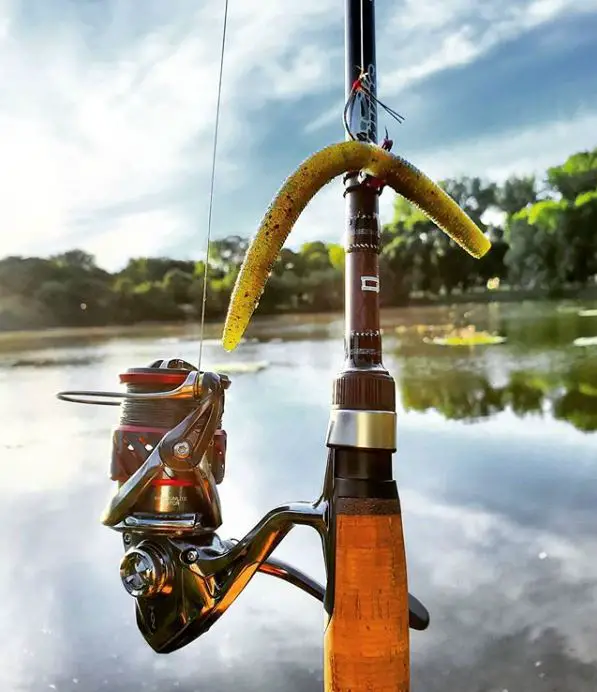
Senkos are beautifully simple. Although it may just look like a chunky round plastic worm, the fall created from the salt impregnation makes fish crazy for it.
It doesn’t look like most other baits, with no distinctive profile besides a taper from the middle out to the ends and very subtle ribs.
However when rigged weightless, this uncomplicated bait falls and wiggles side to side with a very attractive motion attracting even the most passive predator.
Last but not least, the most common size most anglers use is the standard 5-inch classic Senko or Yum Dinger.
Shaky Head
With the pressure on bass increasing, the use of lures as reliable as shaky heads is on the rise. Also known as jig worms, most manufacturers have some kind of soft plastic “finesse” line available.
The problem is that most are made for jig worming rather than bass fishing, making it more challenging to choose the right lures.
Elite Series Pro and Bassmaster Classic Champion Casey Ashley talked about when he first started using shaky heads, he took note of the all characteristics that made it effective.
Ashley summarized, unlike most other bass fishing techniques, shaky head jigging requires patience and attention to detail. It also requires careful gear selection, meaning that if even one of those things is overlooked, the lure loses its effectiveness.
When fishing from the bank a 1/16-to-1/4-ounce shaky jig head will work best with a 4.5-6-inch finesse worm.
On windier days or when fishing in a current, opt for a bit heavier jig head to keep a feel for the bait.
Some other good options are stick worms, plastic lizards, soft plastic jerkbaits, and creature baits.
Mojo Rig
A Mojo rig is like the Carolina rig but slightly modified. Think of this rig as if you were to combine a split-shot rig with a lightweight Carolina rig.
The Mojo Rig is absolutely deadly of the water is clear or if the fish are highly pressured.
Read more: This Finesse Technique is UNSTOPPABLE
Soft Plastic Swimbait
The soft plastic swimbait is bait you MUST have a couple of bags of. There baits are phenomenal because they can mimic both a small shad or bluegill based on the color of the swimbait you buy.
Normally, the only color you need is white or pro blue for shad colors, but if you are wanting a lure to mimic a bluegill then a green pumpkin color works great.
Besides being versatile enough to mimic different species of bait fish, soft plastic swimbaits can also be fished at the top or the bottom of the water column depending on the weighted swimbait hook you buy.
Another soft plastic bait to carry when fishing from the bank is the swimbait. These bass fishing rigs are ideal for imitating bait fish that may be schooling or foraging near shore. A white variation is all you need with this lure.
A common reason many do not get bites on swimbaits is they are using one that is too big. Stick to sizes around 3- to 4-inches for getting the most bites. Fish them on a jig head and simply cast and reel it parallel to the shore. These also double in your bank fishing tackle box as trailers for blade baits and buzzbaits.
Drop Shot
This is a perfect technique for fishing around docks or bluffs where bait fish and other forage take cover. It also is a great way to keep your lure out of the weeds, meaning more fish in hand at the end of the day.
It’s also a fairly simple method since you essentially just drop your drop-shot rig and lightly move it by adding or removing resistance on the line.
Just tighten up the line to get it to move like it’s swimming or loosen it to look more like it’s foraging or injured.
Drop shot fishing can be really difficult for anglers to learn. To save you time, money, and frustration, I wrote the are post where I Tested 15 VIRAL Drop Shot Hacks that Actually Work!
Read more: 15 Quick & Easy Drop Shot Fishing Tips For Beginners
Spring Bank Fishing Tips
In the Spring bass will start to move to clear shallow water once the water approaches 55-degrees and leaves most bass fishermen feeling pretty confident that Spring bass fishing is on its way.
In the Spring, males make and guard the beds with each bed being about 1-to-2-feet across.
Females will arrive a few days after the males do and only spend a few days at the nest once the eggs are laid. The females then retreat back to deeper water, ultimately leaving the males to defend the nest.
And without a doubt, the bass will be at their biggest size, moreover, the majority of females are larger than the males.
When you’re fishing for spawning bass, look for a hard bottom that provides some protection from wind and sun. For instance, overhanging trees or holes around grass are great places to start because although bass like to give their eggs a bit of sun, they typically layout of direct sunlight.
There are two strategies for fishing for bass during the spawn. The first is bed fishing, and the second is search casting.
Sight Fishing For Spring Bass From The Bank
Sight fishing is catching a bass when it’s defending its bed. For many bass anglers, it is a controversial subject. Some believe that if you take a bass off its bed it will spook and never return to the nest, thus harming the future fish.
As a person I tend to believe in science rather than some unfounded opinion. The researchers at the University of Illinois* published a study that concluded that there is little impact on a lake when bass are fished off their beds. Unless that lake is filled with invasive bottom-dwelling species like gobies**.
Arriving To The Lake
Try to get to the lake an hour before sunrise. Arriving a little early gives you plenty of time to unpack and not to hurry to get some predawn fishing in.
Out of your entire arsenal of rods and lures it’s best to try and pick off the most aggressive bass first by using topwater buzzbait or a jerkbait.
Long casts that parallel the bank or shoreline typically work the best.
If you are searching for bass cast out your lure and make sharp, downward pops or twitches of the rod tip. This makes the lure dance and flutters to the bottom.
Buzzbaits
Using a buzzbait during the spring before the sun rises is one of the most unspoken secrets of spring bass fishing.
This bait can be cast a mile with the right rod and reel.
Retrieve this loud clacking lure over points, around structure and parallel to the bank.
Be sure to engage the lure and start your retrieve before the lure hits the water. This will keep it on top of the waterline.
The best spring buzzbait colors are black with a black-and-blue swimbait trailer, or a shad colored buzzbait with a white or pro-blue colored trailer.
Jerkbaits
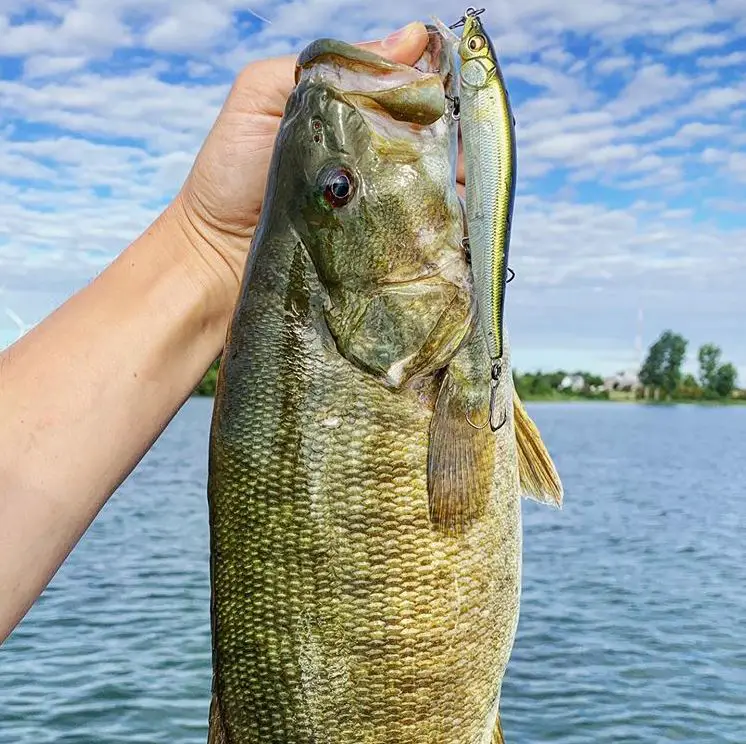
When I first started fishing I didn’t think that jerkbaits didn’t produce until late spring… well that was before I got my butt handed to me during a one-on-one friendly showdown competition that took place in the early spring.
After the beat down I went back to the books and studied and read up on as much spring jerkbait fishing as I could. After years of fishing the jerkbait I now understand there are two primary factors when I chose to fish a jerkbait: water clarity and water temperature.
Let me get this out of the way right now, don’t fish a jerkbait in muddy water. The fish can’t really see it, they can’t really sense it. It’s just a bad bait to throw in muddy conditions.
In contrast, the clearer the water your lake is the better your jerkbaits will perform!
Likewise, jerkbaits will work in ANY temperature of the water, but here are some of my personal guidelines for spring jerkbait fishing….
If the water temp is less than 56-degrees then I’ll choose a suspending jerkbait or even a weightless fluke-style/ soft plastic jerkbaits. At this temperature, bass are pretty finicky and don’t want to go around chasing bait to eat. The best performing jerkbait will either totally suspend or have a very slow rise
There are only a couple of manufacturers that make quality suspending jerkbaits.
First is the Lucky Craft Pointer Minnow Jerkbait and second is the Vision 110 by Megabass Vision 110.
There are only four colors you should carry…
For ultra-clear water are some sort of transparent “ghost” shad color, a “ghost” minnow color.
For stained water, a gold-colored bait or an opaque sexy shad color with a little chartreuse works really well, plus sometimes the bass love to attack bright colored baits like the clown or firetiger color patterns.
Fish these around docks, back of point, or parallel structures such as seawalls.
And finally, the colder it is the longer you want to wait between pauses.
Vibrating Jigs/ Chatterbait-Style
Chatterbaits may work better for you if the water is cooler and there’s some wind.
The ability to slow down the chatterbait (unlike spinnerbaits) makes them easier targets for the bass, especially if they are pre or post-spawn.

The unique lure design allows you to push the bait slowly through grass and wood easily and really irritate those bass.
I recommend fishing the Z-Man Jack Hammer Chatterbait. Its head hangs extra-low giving it a great center of gravity. This allows it to track really well, gives it exceptional skipping properties, makes a hard ‘knock’ sound when it slams itself against a hard piece of structure. Not to forgetting to mention the slightly angles blade of the lure puts off a TON of vibration that make bass instantly aware that this lure is violating their territory. All these features combined make it one of the best vibrating jigs on the market today. They’re pretty hard to find, but luckily you can find the Z-Man Jack Hammer Chatterbait on Amazon.
Texas Rig
Once the sun crests the horizon the topwater bite usually slows. If this happens try using a Texas rigged lure.
Small creature baits or jigs look like spawning bed invaders. Alternatively, if you see a bass flare up its gills and open its mouth up wide to chase away bluegill, try throwing a bait that resembles bluegill. This can lead to some serious action!
It’s helpful to watch how the bass react to your lures. Sometimes they won’t be as aggressive with creature baits as they are with other lures, or they just watch it until it gets too close to somewhere they don’t want it to be.
Getting your fish to commit to your bait takes some experimentation. Every fish is different.
Some of the most productive ways to bed fish during the spring is going to be using the drop shot style, using a bright colored worm, or to use a white jig and trailer.
Another option you can use is a Texas rigged bright colored creature bait.
However, sometimes bass doesn’t attack your white colored worm or jig, that’s when you need to switch out your lures.
If I see the bass chasing bluegill then throw a bluegill colored worm or jig.
If they still don’t bite, then flip out a jig that is bright red. This never seems to fail when I need that bite, the red color is going to be your designated hitter!
Shake It Baby
Don’t forget about the ever-useful shaky head jig. This is an awesome lure to use during and after the spawn.
If you’re sight fishing bass on beds or in the shallows, use a shaky head finesse worm.
Tossing this lure into a bunch of bass fry is usually really effective tool, as the males are still guarding their offspring.
Drop It In Their Nest
Drop shot fishing during the spring spawn is insanely effective. Like the soft plastic creature baits I like to start with the color white or chartreuse first.
Then if no bites occur switch to a natural colored worm. A wacky-rigged bright red worm can be really deadly if the fish has been pressured or caught before.
If you’re having trouble choosing the best drop shot bait, visit the post, Top 10 Drop Shot Fishing Baits You Don’t Know About, where I discuss all the best baits you may or may not have heard of.
Finally, I make sure I shorten the distance from the hook to my drop shot weight to around a distance of 6-inches or shorter.
You want to make it look like your bait is trying to steal the bass’ eggs, so by having a long distance between the hook and the weight the bass won’t feel as threatened.
Read more: These Drop Shot Baits Should Be Banned
Summer Bank Fishing For Bass
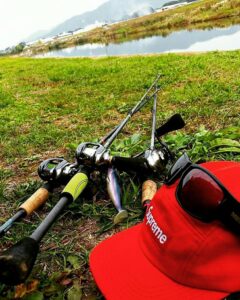 In the dog days of summer, you’ll find the bass can be finicky. Sometimes will eat up fast and loud moving baits on certain days, and on others, they’ll prefer slow for finesse lures. Sometimes the bass will bite like crazy, while other times it seems I can’t buy a bite.
In the dog days of summer, you’ll find the bass can be finicky. Sometimes will eat up fast and loud moving baits on certain days, and on others, they’ll prefer slow for finesse lures. Sometimes the bass will bite like crazy, while other times it seems I can’t buy a bite.
When the bass are up for something fast moving, baits like the frogs, buzzbaits, spinnerbaits, or even crankbaits work amazing during the summer. These baits not only get the attention of the bass being flashy, but they are also loud and big. In contrast, sometimes the bass prefer the slow natural presentation of a Texas rigged 5-inch Senko stick bait, maybe they will like the tantalizing quiver of a thin drop shot worm.
But in order to find summer bass you can catch from the bank you need to find the specific locations the bass will hunker down in the summer. While most bass will retreat to deep water, some stay shallow, so it is important that you know exactly where to look.
There is so much to cover when it comes to knowing all the specifics to summer bank fishing.
Unfortunately, I don’t have time to go over everything in this small section because we could be here for hours, that’s why I wrote a complete report on the best Summer Bank Fishing Tips & Strategies.
Bottom line is that I’m giving you all my tips to get you catching bass fast during the summer.
If you’re interested in learning all the secrets to bank fishing from the summer you can click here.
Read more: Top 25 Summer Bank Fishing Tips (Never Get Skunked Again)
Fall Bass Fishing From The Bank
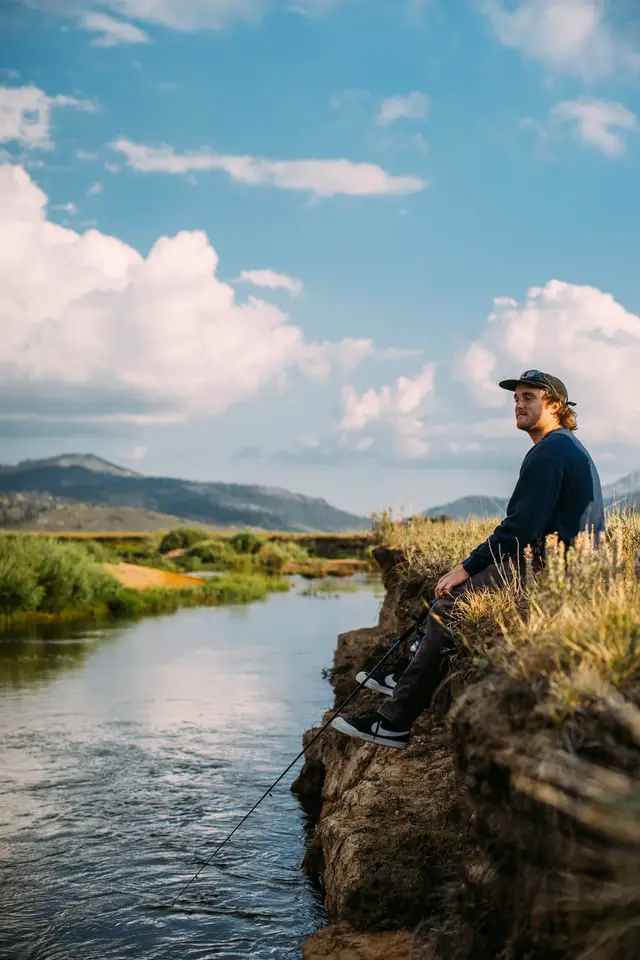
In the fall, a lot of baitfish will move into the shallows followed closely by hungry bass. Oftentimes this movement triggers the bass to feed more actively, preparing for the winter.
Consequently, this is the perfect time to use some fast moving baits. Lipless cranks, squarebills, diving cranks, spinnerbaits, chatterbaits, buzzbaits, spooks, hollow body frogs or anything else that covers the water fast is great for this time of year.
Lipless Crankbaits
In shallow water less than six feet, lipless crankbaits are one of the best choices to target fall bass.
These baits are incredibly easy to fish. Simply cast out and wind back with the occasional pop in the rod tip. Very your retrieve speed from moderate retrieve to burning it back to your position.
I polled a group of tournament anglers and they said the colors they like to use are chrome with black back, or chrome with blue back both in a ½-ounce size.
I wrote a comprehensive article on how to modify your lipless crankbait where I give you a DIY secret tip on how to add weight to the lure all while keeping the same size. This article is a must-read if you like DIY projects, click here.
Jerkbaits and Soft Plastic Flukes
Jerkbaits and soft plastic flukes are great choices when you see aggressive bass chasing schools of shad.
The erratic nature of how these lures are fished often trigger bone crushing strikes.
Keeping the colors natural unless you’re in lightly stained water, where you are best to choose something with a splash of chartreuse.
In most cases, I would choose between a 4-to-5-inch Zoom Super Fluke, the Berkley Gulp Alive Jerk Shad, or Yamamoto 5″ D Shad.
Weightless flukes work great when used while fishing parallel to the bank or straight out.
Furthermore, on days when the fishing is slow. Cast a weightless fluke next to cover and let it fall on slack line. Flukes have a very unique spiraling fall that drives bass nuts. Don’t forget you can also hop or slowly drag is on the bottom as you would a jig.
For hot fall days, look for shaded cover to cast you a hard plastic jerkbait or flip a soft plastic fluke into that spot. If you don’t get a bite the first time, slow it down between pauses.
All bass anglers need to keep hard and soft plastic jerkbaits ready at all times, these will not let you down with the bass at eating shad.
Spinnerbaits
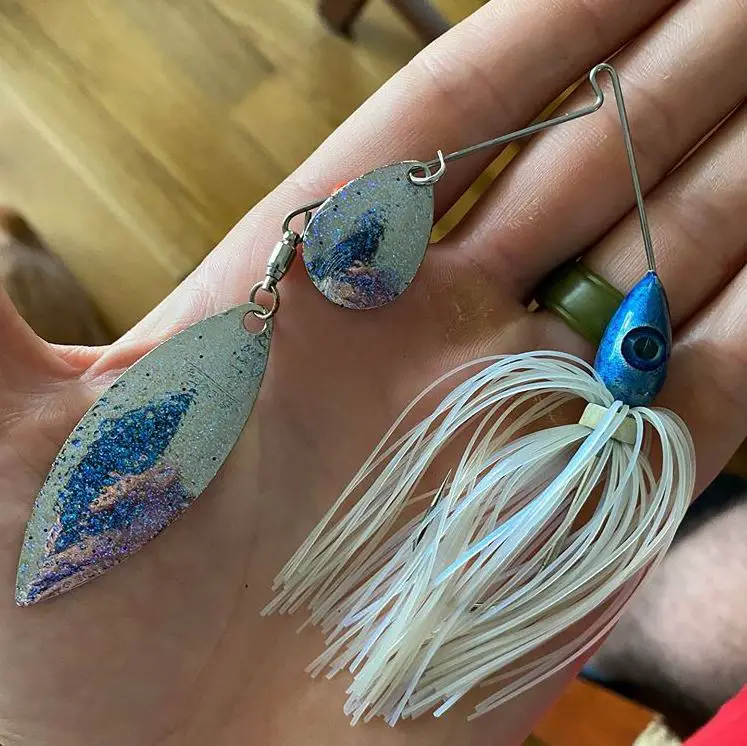
Next to lipless crankbaits, spinnerbaits have to be the next most widely used lure for fall bass fishing.
Fishing a spinnerbait off the bank is incredibly easy and they rarely get hung up.
Since the bass are mainly targeting shad, not only does the spinnerbait does a great job imitating a baitfish, it also puts off a ton of vibration.
The best sizes spinnerbait for fall bank fishing has to be ¼-to-⅜-ounce. Those sizes are not too big to get hung up, but also not too small to not track right.
The spinnerbait can be fished fast or slow, and often has the best result after it’s bounced off a piece of structure like a rock, dock piling, or submerged tree branch.
Drop Shot
Although drop shot fishing works year round, the fall is an especially good time to utilize shad or bluegill colored worms on your drop shot rigs.
Senko
We all know Senkos work, but do Senkos work in the seasons turn to Fall? You bet ya!
I recently asked 54 different anglers what was one way that they fish a Senko in the fall and they overwhelmingly responded weightless Texas rigged or wacky rigged.
Some other response that I received was that on post-cold front days, they suggested downsizing to a 4-inch worm and fish it with either a Mojo Rig or a neko rig.
If you don’t know what a Mojo rig is, then click here. It’s an awesome finesse technique.
Winter Bass Fishing from Shore
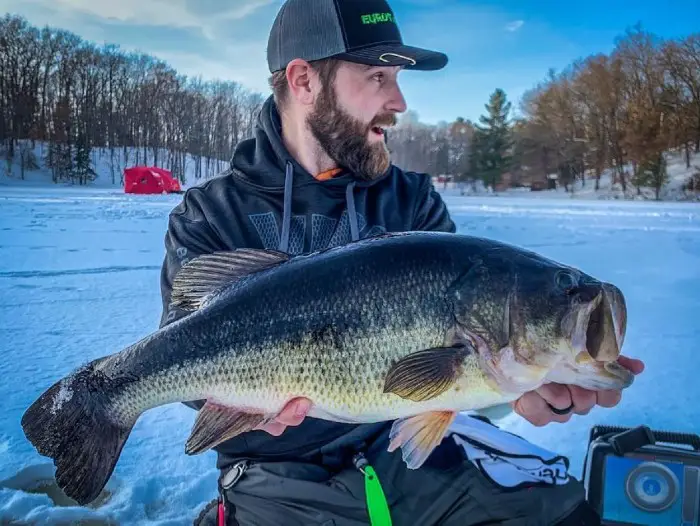
When Old Man Winter comes and drops the water temperature below 50-degrees it can be one of the hardest times to fish for bass, especially if you are bank fishing. But I’m here to tell you it’s not impossible to catch bass in the winter from shore. Here’s how I do it…
Flat Side Crankbaits
Start with a shallow running flat-sided crankbait like the Spro Little John Crankbait, casting it along rocks or debris that is closer to shore. Move the crankbait very slowly on the bottom, bumping into obstacles, and encouraging a reaction strike from cold, lethargic bass.
Winter Drop Shot Tips
Professional angler Johnny Johnson once said, there’s a special saying that for drop shot fishing in the winter, you want your baits to be small, short, and boring.
Fish see these as less exhausting meals, meaning they’ll burn less energy while staying fed over the winter.
You don’t need much more than some small drop shot worms, soft plastic chunk baits, or even small fluke-style baits.
Black and blue colors typically will work the best, however if the water is really clear water then use any natural brown or green colors.
Winter time drop shot fishing can be one of the easiest ways to catch winter time bass, but there are a handful of very important things you cannot forget to do. When you’re done here you need to read the post, How to Catch Drop Shot Bass in the Winter.
Carolina Rig
Most people think the Carolina rig as a big bait summertime technique. However, there are some things that certain professionals will do that alter the action for wintertime fishing.
The gear is kept the same. Using a long medium-heavy to heavy action rod with a fast tip. Paired with a baitcasting reel that is spooled up with only 12-to-17-pound fluorocarbon line.
Like the traditional Carolina rig thread on ½-to-¾-ounce tungsten flipping weight and 1-2 brass beads. Then I tie off the flurocarbon line main line to a large barrel swivel. You may be saying ya-ya I know how to set up a Carolina rig. There’s nothing special about that. Here is where it gets a little different…
Instead of using a leader line that is 17-pound fluorocarbon that is 8-to-10 feet long, I tie on a really short leader that is 6-12 inches using 10-12-pound fluorocarbon.
Now you’re probably thinking, “you’re bat-S#!t crazy!”. But believe me, you need that line to be shorter, giving the bait a more subtle action in the colder water and a lighter line because that water is so clear during the winter.
Crawl this winterized C-rig over the normal spots you would crawl this targeting winter fish. It works!
Best Locations to Catch Bass From The Bank
Most people scoff at shore fishing because of the limited access to the water, which is especially frustrating if you’re used to cruising around the entire lake.
One great thing about fishing most lakes is that man-made structures exist, and those are oftentimes perfect places to find fish.
Man-Made
Bass many times rely on man-made structures to provide them food and shelter.
Take boat launch ramps and marinas for example. The floating structure provides cover overhead. And the structure will also grow moss which will then attract bluegill and other bait fish, which will attract bass.
Here’s a super secret ninja tip… A lot of times the construction crews will dump piles of rock a rubble 30-50 feet away in the lake before they fill it up.
This creates a man-made hump that can hold bass. So check with Google Maps because sometimes you’ll see those humps on the satellite view.
Selfie Central

photo @basslife365
Another great thing about launch ramps and marinas is what I call the “selfie effect”. This is present when anglers come back from the day, take a few pictures with the fish they caught, and release them at the ramps.
This gives you an awesome refresh of bass, but quite often the largest catches of the day are the ones that get dropped off at the ramps.
So when you see tons of fishermen on the shoreline, don’t think it’s all fished out; it might just be so heavily replenished from the “selfie effect” that there’s more than enough to go around!
Go Natural
Oftentimes these small, shallower lakes are full of grass and being disinterested in finding a productive spot, anglers will opt to travel further away rather than fish close to home. However, these grassy areas can be very productive and not too overwhelming to manage.
Look for places where the grass forms points or small dips. These are places bass like to camp-out, waiting to ambush whatever is coming around the area.
Use the same observations when bank fishing. If there is just a lot of straight bank, I wouldn’t spend too much time there.
Another thing to look for is a lay-down, whether it’s wood on rocks or in the grass, bass will almost definitely be sitting on them.
[HUGE] Bank Fishing Tip
Use a Portable Fish Finder!
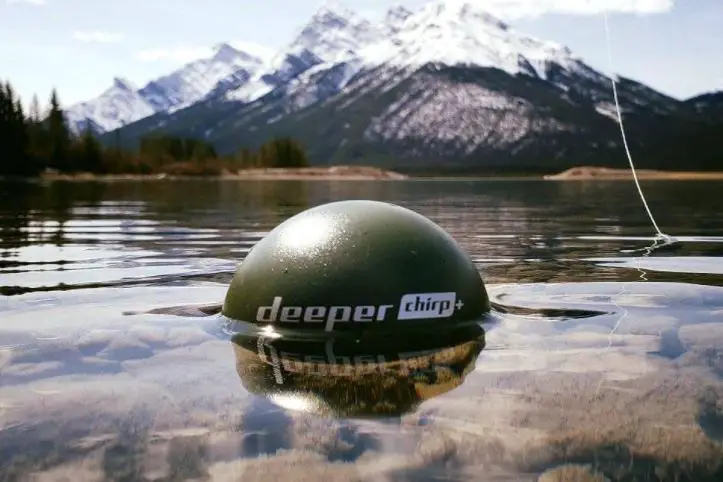
photo @deepersonar_uk
You may have seen portable fishing finders (or ‘fish sonar’) on market recently and without a doubt, they absolutely changed bank fishing forever. To get the best result out from your time on the water, you need a fish sonar that can tell you exactly where the fish are hiding and what the surrounding underwater structure looks like
Having access to a portable fish finder can change the way you fish a location and can make the difference between catching nothing to filling up your stringer.
However, in order to increase your chances of catching a fish the sonar unit you choose has to actually work as advertised, easy to use and last a full day of fishing.
In the early days portable fish finders were bulky, displayed unreliable data, and would burn out of battery power in a matter of an hour or two.
Luckily, recent advances in technology has allowed some of these systems rival sonar units that can cast a thousand dollars or more!
Surprisingly there are some great fish finders you can cast from the shore.
I recently tested several of them and a couple had incredible sensitivity, easy to set up and use and even had some great warranties.
Unfortunately in others, I noticed some quality issues I saw with a couple of well-known portable fish finder manufacturers.
Best Casting strategies from the bank
One great casting method for bank fishing for bass is to “fan-cast”.
According to Bill Dance, you should think of it as an oriental fan and start casting to cover the area in a fan pattern.
Start on one side and work your way across, moving side to side.
It’s not uncommon to find bass hiding in just inches of water where it meets the mud, so don’t skip any spots.
Be “Ninja Quiet” and Dress for the Occasion
Just like if you were turkey hunting, camouflage is an important part of your gear. If they’re close it makes them easier to catch, but if they see you it’s often game over. For that reason, it’s best to stick to natural, neutral colors that match your surroundings.
I learned this trick the hard way while trout fishing in Colorado. For some reason, my buddy was catching six fish for every one I reeled in. I finally had to ask, “What is going on? Why are you catching more fish than me?” I realized then that it was my bright red trucker hat, compared to his brown one. The fish can see the big bright hat as a warning flag, spooking them all away!
It doesn’t matter if you’re not big into hunting, camouflage or at the very least neutral colors help you to blend into the surroundings, hiding you from shallow water bass.
Keep Your Voice Down
It’s very important to walk quietly and softly because the bass close to shore can feel that in the lateral line. Similar to how they feel (hear) rattle-traps, they feel you walking and know you’re there.
It’s not like you need to be completely silent. Noise still exists there, so just be reasonable and talk at a normal volume, but remember that the bass can actually feel you walking.
Attempt to be as stealthy as you can, but still, enjoy your time on the water.
How To Stay Organized Fishing From The Bank – Best Tackle Bags For Bass Fishings
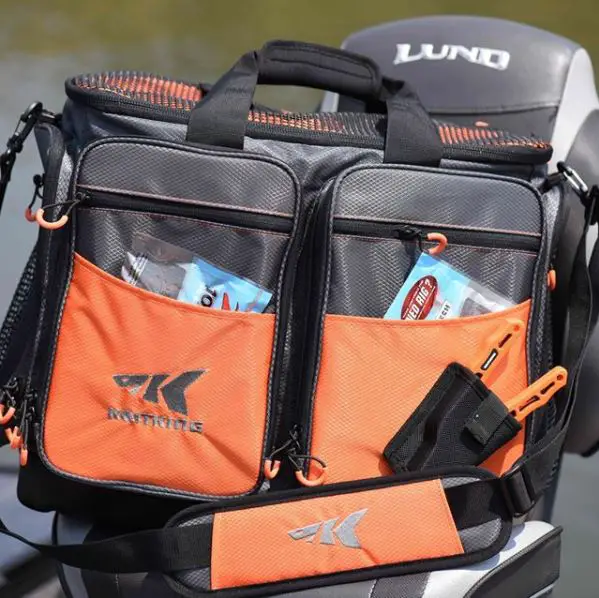
A box is great for boating, but what you really need for bank fishing is a tackle bag or backpack.
The rigidity of tackle boxes not only makes them comfortable but prone to tipping over on uneven surfaces. Bags are flexible, making them much more comfortable to wear while moving between fishing areas, which is something you will be doing often when fishing for bass from shore.
A perfect tackle bag that is portable and has an effective organizational system creates that perfect balance between efficiency, mobility and comfort.
The tackle organization system is one of the most important features of a good bag. The interior should be separated by having plenty of room to hold three Plano tackle boxes and some extra internal zipper panels under the lid flap is also really helpful.
Externally, tackle bags should over offer side pockets to put extra tackle, bags of soft plastics, and tools such as a scale or pliers.
Strong and durable large size zippers are a must to prevent shifting tackle accidentally opening up a closed bag.
The bottom of the tackle bag also needs to be reinforced to resist water, mud, rocks, and anything else Mother Nature decides to throw at it.
Last, but definitely not least straps must be padded or comfortable.
If you’re interested on finding the best and most comfortable tackle bag for then head on over to the post, Best Tackle Bag for Fishing [Review Guide], where I discuss the cool details and mind blowing features that some of these bags now come with. They are soo cool. Click here to learn more!
FAQ
Is it legal to use a bank fishing rod holder?
Most likely the answer is yes. However, you must check with your own local and state laws. Some places will allow you to use a rod holder but you cannot leave it unattended. Some private lakes will not allow bank fishing rod holders at all. Regardless, make sure you do your homework first to ensure bank fishing rod holders are legal in your area.
What's the trick to bank fishing in the wind?
Bank fishing in the wind can be difficult. Honestly, this question probably demands an article all by itself.
Briefly put, if you’re casting into the wind, it’s best to use heavier lures or weights. Increase your normal weight by 1/16-to-1/4-ounce.
If you’re bobber fishing a water bobber works really well. You can even find these on Amazon.
Getting Started With Bass Fishing? Read These Articles First...
- How To Catch Bass – 57 Fool-Proof Methods To Start Bass Fishing [Made Easy!]
- 5 Best Bass Baits Every Angler Must Own (Are You Missing Out?)
- Best Bass Fishing Lures 2024: Comprehensive Buyers Guide
- Bass Fishing Rod Secrets: Helps You Chose The Right Type Of Rod Faster!
- 21 Tips To Choose The Best Bass Fishing Line
- WARNING: Don't Even Think About Trying To Buy Your Fishing Reel Until You Read This...
- Water Clarity Guide for Bass Fishing [Blueprint Revealed]
- Top Secret! Catch Bass From the Bank Every Time
- 25 Night Bass Fishing Tips and Tricks
More articles just for you...
Selecting Early Summer Bass Fishing Lures [Avoid 5 Common Mistakes]
A Complete Buyer’s Blueprint On The Best Early Summer Bass Lures On The Market Today! When it comes to bass fishing, choosing the right lure
Early Summer Bass Fishing [Avoid These 3 Sneaky Lies]
Learn these closely guarded secrets early summer bass fishing … and… dramatically boost your advantage over other anglers! Late spring to early summer bass fishing
Fear The Finesse? 7 Ned Rig Fishing Secrets Exposed!
Conquer the Fear of Finesse… and… Unlock the Potential Ned Rig Fishing – TODAY! Fellow Angler… Like most of you I’m pretty set in my
Fishing Spawning Bass [18+ Lures & Gear]
Get Ready For The Spawn Now When bed fishing, stealth is of the biggest essential tip. Instead of racing forward with a trolling motor, anglers
[2024 Editors Choice] Picking The Best Bass Fishing LINE For ANY Budget
What is the best bass fishing line? | What is a good fishing line for bass? The best type of bass fishing line is based
Drift Sock Basics – What It Is A Drift Sock & How To Use It [2024 Quick Start Guide]
What Does A Drift Sock Do? | Why Use A Drift Sock? photo cred: WLUK We’ve ALL been there… you work your butt off the

